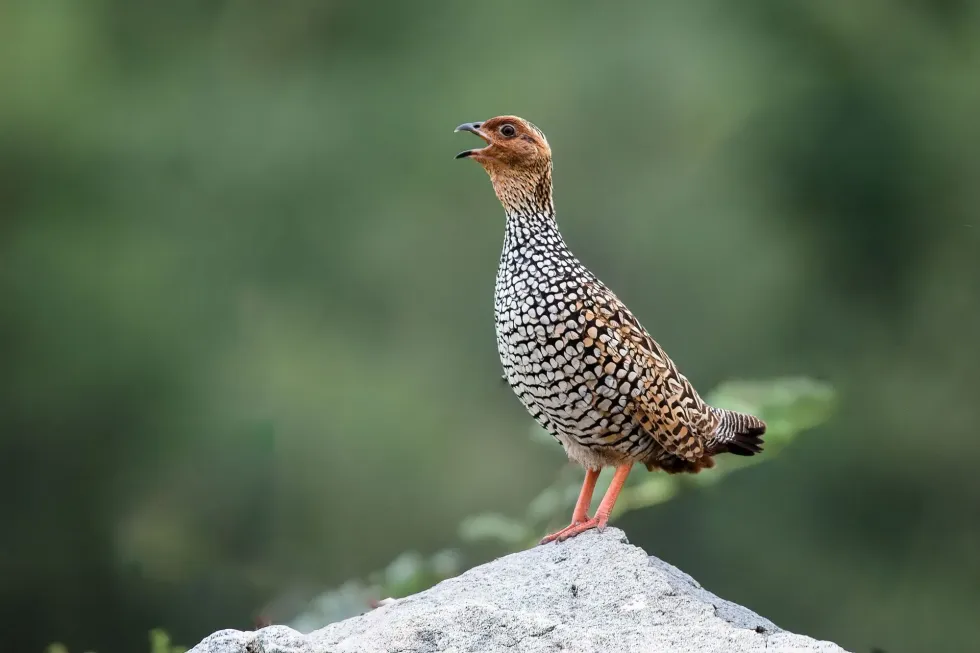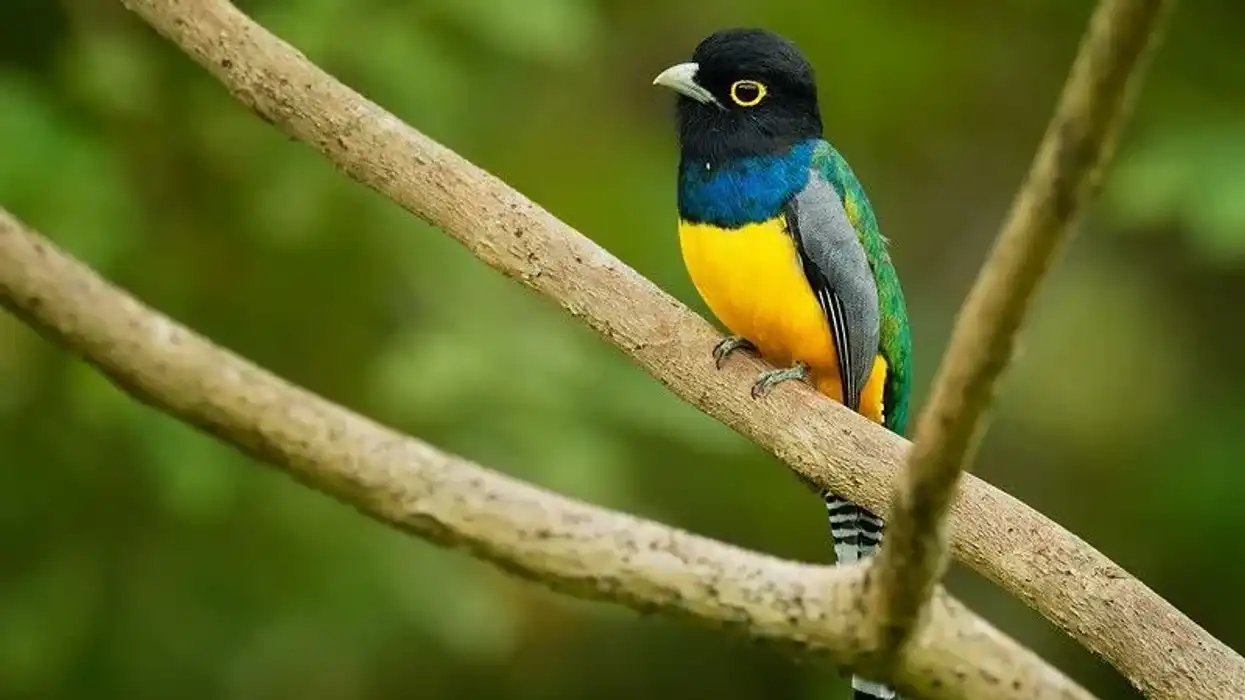Francolins are non-flying, terrestrial birds that eat insects, vegetative debris, and seeds. Their loud calls are easily detected, especially during the breeding season.
The bird species francolinus pictus has mostly been found in Central India, east of the Western Ghats and south of the Narmada, but also in the Chota Nagpur and Northern Circars. It is only mistaken with the black francolin, with which it somewhat overlaps and is known to hybridize on occasion.
The lack of a rufous hind collar and the white dots on the underside distinguish this bird species from the female of a black francolin. There are three subspecies of this bird.
The nominate population is found in Central and South India south of 20°N, whereas the form pallidus is found farther north (type locality Udaipur). The upper parts of this variant are paler.
The Sri Lankan race is known as watsoni. It is only found in southeastern Sri Lanka, where it extends from the Uvala patanas east to the low-lying area of Nilgala and Bibile.
Their all is similar to the Black Francolin. You might also want to take a look at pileated woodpecker and yellow-billed cuckoo.
Painted Francolin Interesting Facts
What type of animal is a painted francolin?
The painted francolin (Francolinus pictus) is a partridge bird belonging to order Galliformes, family Phasianidae, and genus Francolinus. It is also known locally as the teetar and the bhoora (brown) teetar owing to its loud repeated cries that sound like 'ka-tee-tar-tee-tar' and its hue.
What class of animal does a painted francolin belong to?
Painted francolin (Francolinus pictus) belongs to the class of Aves just like lovebirds, Phasianidae family, genus Francolinus.
How many painted francolins are there in the world?
The population range of this bird genus species (Francolinus pictus) has not yet been assessed. We do know, however, that its populations range is constant across its primary distribution areas, notably India, Pakistan, and Sri Lanka.
Where does a painted francolin live?
The painted francolin (Francolinus pictus) is a francolin bird species found in the lowlands of the southeastern Sri Lanka range, as well as the grassy regions of central and south India.
What is a painted francolin's habitat?
The painted francolin (Francolinus pictus) prefers drier and scrubbier habitat distribution than the black francolin, but not as dry as the grey francolins, habitat. The painted francolin is only found in India and Sri Lanka.
The painted francolin (Francolinus pictus) is a common inhabitant of southern India and Sri Lanka. The bird may be spotted in Kota, which is the closest area to Delhi. This bird species distribution is to the south of the black francolin's range.
It can be found in patches in semi-dry undulating grasslands with scrub or agricultural habitat. It inhabits drier zones than the black francolin but wetter zones than the grey francolin.
Who do painted francolin live with?
Painted francolin (Francolinus pictus) is usually observed in small groups. They have been spotted roosting in flocks on low thorny trees in India and Sri Lanka.
How long does a painted francolin live?
The painted francolin (Francolinus pictus) is a bird species belonging to the order Galliformes, family Phasianidae, and genus Francolinus, that can live up to eight years in the wild! It is common in India but has currently not been recorded in south India.
How do they reproduce?
Eggs are laid by all birds to reproduce. Eggs are laid within the female species and subsequently laid in a nest.
Egg-laying, which is the equivalent of ovulation in mammals, may occur in confined female birds without fertilization or even the presence of a male.
In certain species, both female and male birds sit on the nest, but others either leave this task to the female species exclusively or rely on nature to supply the warmth required for the developing baby.
In most pet bird species, both parents actively engage in chick incubation, feeding, and care. Their nest is a secluded scrape in the earth.
It can also be constructed on a rock or a wall. These partridge bird species pairings are monogamous since they have been recorded breeding with the same partner year after year in India.
What is their conservation status?
The conservation status of painted francolin has not been evaluated yet. Locally abundant in the Indian subcontinent, this species (Francolinus pictus) of Galliformes order, family Phasianidaemay interbreed with black francolin in a small portion of Manipur. In Sri Lanka, the the watsoni is threatened.
Painted Francolin Fun Facts
What do painted francolin look like?
Francolinus pictus bird species is characterized by the pale chestnut sides of the head, which lack the black neck edging found in grey francolin.
Both sexes are similar with small variations, and the hen has a whitish neck at times while the hen has chestnut - both sexes are without spurs. The male painted francolin has a rufous face, a white neck, and black and white feathers that are highly mottled.
Females resemble its near relative, the black francolin, but with a darker head (still rufous) and back; a mottled black and white breast that is less pronounced than in males.
How cute are they?
The painted francolin (Francolinus pictus) is a charming small brown bird that fits in a teacup. Their attractiveness stems in part from their tiny height and plump body form, which is highlighted when they puff up their speckled feathers.
How do they communicate?
The call of Francolinus pictus is similar to that of black francolin. They call in the early morning and their call has been characterized as a guttural broken crow.
When you're close enough, you could hear a preliminary click. It is generally heard giving a call from a high vantage point, such as a mound, shrub, or tree stump. They may call at dusk during the non-breeding season.
How big is a painted francolin?
These birds (Francolinus pictus) are tiny, averaging 12 in (30.4 cm) in length.
How fast can a painted francolin fly?
Francolinus pictus are terrestrial (though not flightless) birds.
How much does a painted francolin weigh?
These birds (Francolinus pictus) are tiny, weighing between 9–12 lb (4–5.4 kg).
What are the male and female names of the species?
Males and females of the species (Francolinus pictus) do not have distinct names.
What would you call a baby painted francolin?
A chick is a name given to this bird's (Francolinus pictus) young.
What do they eat?
Francolinus pictus eat grass seeds such as Brachiaria ramosa as well as cultivated rice grains. Insects such as beetles and other insects are also consumed. They also eat Cyperus rotundus tuberous roots. Bombay cats, small Indian mongeese, and pigs are said to prey on it.
Are they dangerous?
No, these birds are not threatening, and they have never been proved to be dangerous to people.
Would they make a good pet?
When you have limited room, mobility, or money, and you spend a lot of time alone, a pet bird or a couple of them could be a suitable choice for you. Birds may be excellent companions for older people, single children, and pet-free families, providing company and delight for many years.
Did you know...
This bird appears on a Sri Lankan postal stamp worth 4.50 rupees.
How many eggs do painted francolin lay?
The nest is a squiggle on the ground. A clutch of six to seven smoky white eggs is deposited.
Does painted francolin migrate?
It is endemic to central and south peninsular India and Sri Lanka but has lately been absent from most of south India. It lives in farmed and open habitats with scattered trees and extensive undergrowth, where it is concealed for most of the year.
Here at Kidadl, we have carefully created lots of interesting family-friendly animal facts for everyone to discover! For more relatable content, check out these black-billed cuckoo facts and leghorn chicken facts for kids.
You can even occupy yourself at home by coloring in one of our free printable painted francolin coloring pages.










